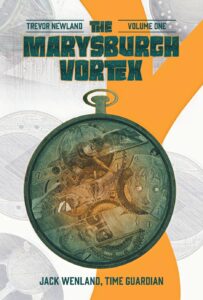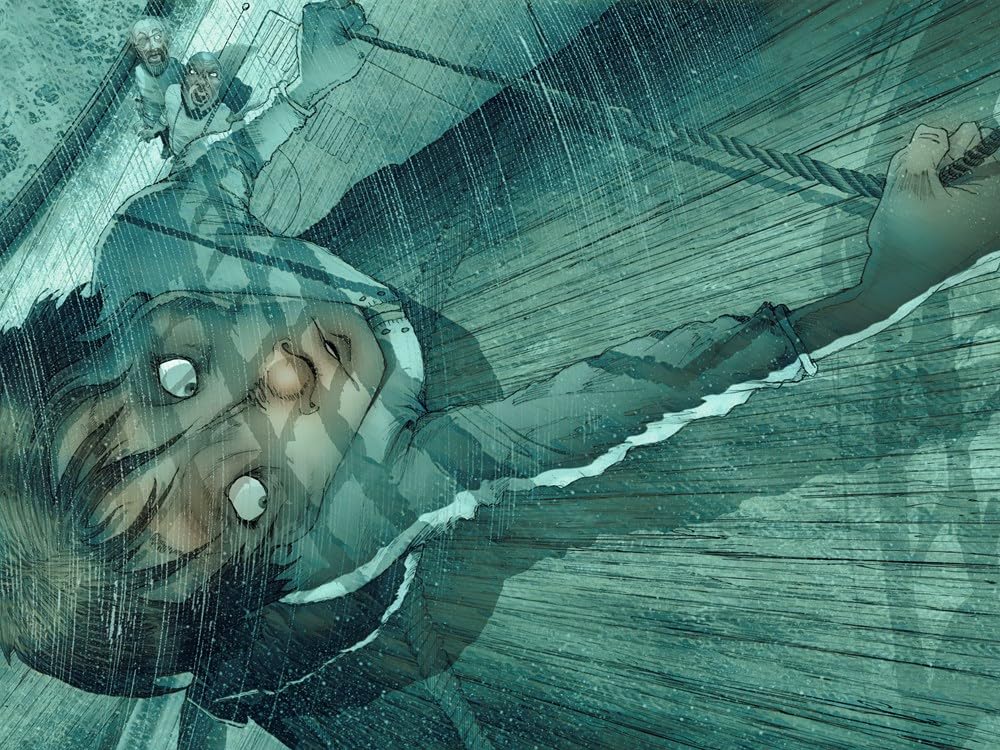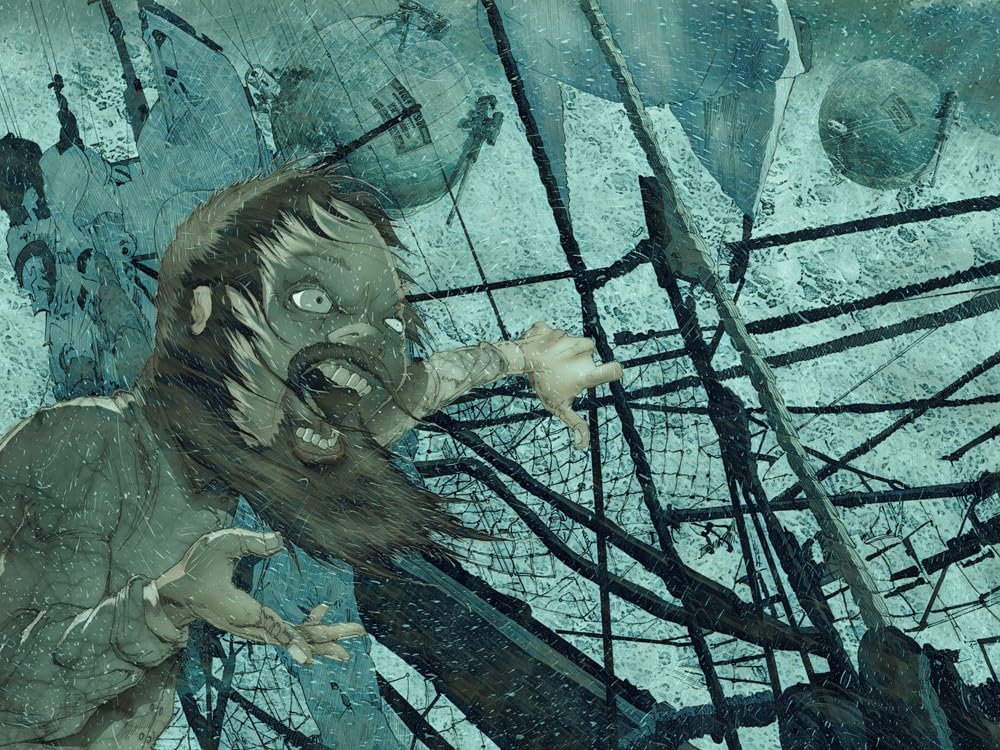Nefarious investments, cool drones
The Marysburgh Vortex (Volume 1: Jack Wenland, Time Guardian)
by Trevor Newland
Vancouver: Simply Read Books, 2024
$22.99 / 9781772291001
Reviewed by Peter Babiak
*

“There is a widespread refusal to let children know that the source of much that goes wrong in life is due to our very own natures—the propensity of all men for acting aggressively, a-socially, selfishly, out of anger and anxiety.” —Bruno Bettelheim, The Uses of Enchantment
If you like intense adventure stories told thoughtfully and with a narrative eye admirably trained on real history reimagined with literary prowess, then you should read The Marysburgh Vortex—even if novels unwisely categorized as Children’s or YA Literature aren’t your typical reading material. They aren’t mine, either, but this elegantly illustrated historical sci-fi novel by Vancouver resident Trevor Newland eschews that default niceness that typifies so many books intended for young readers, rendering them unappealing to older ones. Plotted around the intriguing occurrences around the fabled ‘Marysburgh Vortex’ of Lake Ontario—aka, The Graveyard of the Lake—where a few hundred ships have gone missing and crews disappeared, his novel is anchored on two of our most pressing concerns today: environmental degradation and the disconcerting progress of technology.
It opens with a Prologue set in 1641 aboard The Merchant Royal, a ship blasted by a storm somewhere between the Spanish and Belgian coasts and then assailed by “flying demons” as it sinks. This narrative frame—creatively adapted from the legendary ‘British Gold Ship’ that sank off the English coast that same year with a cargo worth two billion dollars that was never located—anticipates events addressed over the course of the novel and, no doubt, in the next volumes of Newland’s planned series.
The story proper, building on the maritime theme, begins in 1889 in Oswego, New York, a town on the American side of Lake Ontario. Here we meet our protagonist, 17-year-old Jack, an orphan who’s been eking out a living as a deckhand on fresh water cargo schooners. Plagued by recurrent “trace memories,” Jack has no recollection of his life beyond the last year. Before this point, “his life faded away like a country road stretching out into the dark night.”
The mystery evolves into full-blown goosebump suspense when we find ourselves in a maelstrom of events that, over the next one hundred pages, will push through the laws of physics and our understanding of linear time. Shots are fired, a body lay dead on the ground, a gun is pointed at Jack’s head. The young man is knocked out and wakes up in the “alchemical den” of one Dr. Huxley Volf. With its “bizarre machinery and floating symbols,” and “blueprints, see-through machines, cogs and gears spinning and twirling and squatting there in the nothing,” a futuristic cave disorients Jack’s nineteenth-century eyes. Digital technology would probably appear spectral—“squatting there in the nothing”—to someone from 1889 who’s only heard about Edison, much like the technology that awaits in the future might look to us.
As it turns out, Jack is from the year 2197 and has travelled back to 1889 with his parents to save the world from immanent collapse. Much of The Marysburgh Vortex is built on redolent phrases that wrap themselves around contortions of time and space, but Newland’s talent with the architecture of sentences never detracts from the exhilaration of his plot, with its strange events and estranged sense of time.

Not surprisingly, it’s his characterization of Dr. Volf, an archetypal eccentric genius with a foreboding Germanic name, that sustains the exhilaration in this first volume. Described as “a little god in a dark cave,” Volf is a Sturm und Drang antagonist who inhabits that delightfully ambiguous moral space unburdened by questions of right and wrong. Though cut from the same cloth as Victor Frankenstein and Lord Voldemort, at points he recalls literary history’s best antagonist ever, Milton’s Satan. But Newland updates his evil lustre, casting Volf as a messianic technocrat and speculative capitalist, rather like a manic Elon Musk figure whose excessive faith in his own abilities liberates him from all sense of public good.
Slowly and by degrees, Volf’s motives become clear to Jack, as do the young man’s memories. When, for example, the Doctor offers him five hundred dollars to help move equipment from his cave to his ship moored nearby, he lets slip that the amount is greater “than you’ll make for the entire season as a deckhand on any schooner in 1889.” To which Jack, astute to the placement of prepositional phrases, “frowned at the odd phrase. Why ‘in 1889’?”
And here we’re pulled into the space-time nexus of Newland’s dazzling plot. In 2197, the world is on the brink of climate catastrophe, “billions of zombielike souls roaming the streets for scraps of food, the air foul and unbreathable.” Two meteorologists, Jack’s parents, travel back to the late nineteenth century to retrieve the one chemical element they need to restore the world’s ecological balance. But Volf, the physicist whose “time jump device” they have used to get there, kills them. He even seems to relish recounting the details of their deaths to their son, too.

But the young man possesses a heroic intellect, like the protagonists in Hunger Games, Divergent, and The Maze Runner, and has no qualms thinking and acting outside the code of morality. Here, for instance, the narrator describes Jack’s response to Volf news about his parents: “He felt a faint black anger dredging up inside him far beyond the blackness of the amnesia that had stolen his past.” That sentence, a beautiful justification for the ugliness of revenge, speaks volumes about Jack’s character, and will resonate with any reader, especially younger ones. It echoes Christoper Hitchens’ defence of “subversive” children and YA author Roald Dahl, who had drawn all kinds of criticism but knew all too well that young readers “understand cruelty and unfairness and … are capable of relishing it.” With no compulsion to hallucinate that a person’s darker side doesn’t exist, Jack embraces it, and escapes Volf’s ship into the ess of Lake Ontario.

It’s Volf’s sinister genius that drives the plot of The Marysburgh Vortex, and Newland has done admirable research to thread that fictional genius into real history. Not only has Volf killed Jack’s parents, with his ability to move across time he’s been plundering the past in a speculative game of wealth accumulation that involves, among other mysteries, capitalizing on all those ships lost in the Graveyard between coast Ontario and New York. He’s like hedge-fund manager plying his long-short strategies backwards in marine history: “Read a history book. Program in the location. Send the drones. Create the storm. Sink the ship. Grab and bury the treasure here and now with other drones. Over and over again.”
Credit to Newland (The Atheneum) for thinking up such an enticing plot. And the degree of his antagonist’s pride and capacity for evil is accented in the illustrations. At a climactic confrontation, to take one example, we see Jack’s open hand tempting Volf with the quantum computer chip Volk needs to move across time and ply his nefarious investments. An inversion of the familiar temptation motif, Volf’s spectacled profile betrays his willingness to do anything to maintain what he calls his “breakaway civilization of one.” A steampunk aesthetic marks Newland’s art work, making Volf sometimes look like a Dr. Seuss figure who’s gone off the deep end, though these striking illustrations are also reminiscent of sources as diverse as the Brothers Grimm, H. P. Lovecraft, and The Matrix.
The novel is erected on two classic literary tropes—the orphan and the mad scientist—and both, I’m sure, would be a treat to any young reader.
But I found most compelling is Newland’s imaginative rethinking of real history in the service of his sci-fi adventure. The marine mystery of Lake Ontario’s ‘Marysburgh Vortex’ is quite real, as are the fates of the two ships Jack works on in the novel. The Bavaria, a real schooner whose entire crew mysteriously vanished in the Vortex in 1889, befalls a similar fate in Newland’s retelling, though here the missing crew—save for Jack, who escapes overboard—is the nefarious work of “Volf technology.” Along with its Captain Sidley, the schooner The Picton, which moved coal between Ontario and New York, sank in 1900 during a sudden surge in the Vortex. Jack works for Captain Sidley near the end of Volume 1, when its perplexing disappearance and the death of its captain are still eleven years in the future and bound to be written about in Newland’s subsequent volumes. His historiographical imaginings even include fictionalized newspaper reports from the Kingston Whig Standard and Prince Edward Gazette, which lend a degree of authenticity to this intriguing corner of Great Lakes history.
It’s Newland’s creative retelling of historical events, along with his implied critique of the unchecked progress of technology, that captivated me while reading The Marysburgh Vortex. His attentiveness to the writtenness of history, real or imaginatively retold, is nothing short of breathtaking. His prose reminds us that Northrop Frye’s well-known claim that writing for young readers should “cast off its Cinderella rags” and be read “for its own sake and for its inherent values” has, in fact, come to pass. Even so, younger readers will be most taken by Jack’s story and his dealings with the evil Dr. Huxley Volf, with his fanciful quantum theories, time travels, and very cool drones.

*

Born and raised in the GTA, Peter Babiak now lives and writes in East Vancouver. He teaches linguistics, composition, and English Lit at Langara College, and writes for subTerrain magazine. His commentary and creative nonfiction has been nominated for both BC and national magazine awards; his collection of essays—Garage Criticism: Cultural Missives in an Age of Distraction, published by Anvil Press in 2016—was a Montaigne Medal finalist and an Honourable Mention in the Culture Category of the Eric Hoffer Awards. His essays were selected for The Best Canadian Essays in 2017 and 2018. He has a dog, a cat, a garden, and an alluring garage. [Editor’s note: Peter Babiak has reviewed books by Brian Dedora, Stephen Bett, Claire Wilkshire, Heather Haley, Trevor Newland, Douglas Coupland, Clint Burnham, Stan Rogal, and Jamie Lamb; his book Garage Criticism was reviewed by Ginny Ratsoy, for BCR.]
*
The British Columbia Review
Interim Editors, 2023-25: Trevor Marc Hughes (non-fiction), Brett Josef Grubisic (fiction and poetry)
Publisher: Richard Mackie
Formerly The Ormsby Review, The British Columbia Review is an online book review and journal service for BC writers and readers. The Advisory Board now consists of Jean Barman, Wade Davis, Robin Fisher, Barry Gough, Hugh Johnston, Kathy Mezei, Patricia Roy, Maria Tippett, and Graeme Wynn. Provincial Government Patron (since September 2018): Creative BC. Honorary Patron: Yosef Wosk. Scholarly Patron: SFU Graduate Liberal Studies. The British Columbia Review was founded in 2016 by Richard Mackie and Alan Twigg.
“Only connect.” – E.M. Forster
2 comments on “Nefarious investments, cool drones”
Peter, terrific review. You’ve got me excited for the book! Thank you
Thank you, Mike! I think terrific reads inspire decent reviews!.